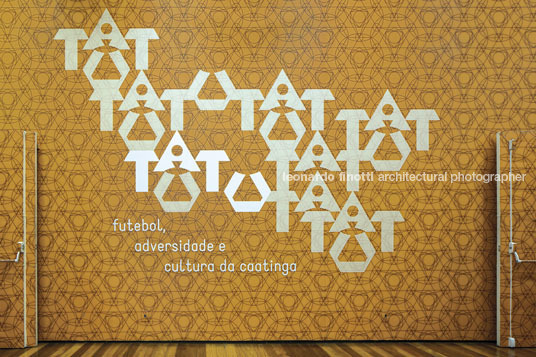tatu-futebol, adversidade e cultura da caatinga - mar rio de janeiro rj, brazil
- description
Armadillo: Soccer, Adversity and the Culture of the Caatinga
The armadillo isn’t blue. Its brownish shell warns us that the three-banded armadillo is not bound to the skies, but to the ground. The armadillo-ball can’t fly, but it has a form of defence: It rolls itself into a ball as a protection against not knowing how to dig a hole in which to hide. It is to this feature that it owes its Portuguese name tatu-bola: “ball-armadillo”. Protected against natural predators, it is easy prey for man and is, therefore, a victim of environmental imbalance. Everything about the three-banded armadillo lends itself to the hot red ground of its habitat – the caatinga –, which are the dry sertão hinterlands which spread through part of the North and Center-West of Brazil, and through a large part of the North-East.
Some have reduced the three-banded armadillo from World Cup mascot – an opportunity to develop into a reflection on a global scale – to the symbol of soccer worldwide. A sad fate. The expectations of environmental protection movements were that the World Cup would contribute towards saving the armadillo from extinction and towards the increase of appreciation for its habitat. Hence they gave it a name which stems from the combination of two Portuguese words, FUteboL (soccer) + ECOlogia (ecology) = Fuleco. The caatinga, the only biome that is exclusively Brazilian, is both abundant and arid at the same time. A place that is entwined with misery and branched with immense sociocultural richness, its history and its culture of resistance are marked by adversity.
The choice of the three-banded armadillo as the mascot for the World Cup launches, here, the political challenge of this intense moment in the country’s public life: how to consider the ball – the game in its most common form, as well as the sport in its professional aspect – from the perspective of the armadillo? Certainly a kind of armadillo-thinking can ask productive questions to reflect on the present and future of Brazil. Questioning the stereotypes of the ball, and therefore football, the armadillo questions the territorialities that appear alongside it: what type of Brazil is shown by this creature, and what Brazils might be supressed by the blue shell of the mascot version?
Armadillo: Soccer, Adversity and the Culture of the Caatinga establishes itself from the point of view of the living creature itself. The imaginary of the caatinga, of the armadillo and of the ball conducts itself here through the perspective of the adversity that governs the history of Brazil. Art and cultural artefacts roam the bright and hot ecosystem of the caatinga, the armadillo in the mythology of indigenous societies, the symbolic and political invention of the sertão – drought, cangaço (a form of social banditry), social literature, the cinema novo movement, contemporary art –, even the soccer of the adverse ball (not the FIFA standard ball, but the irregular armadillo-ball that the creature rolls into), the game understood as an important form of sociability and of resistance. Starting from the armadillo, it is possible to experience the ball in its reinvention of spherical perfection, getting close to the political force and to the aesthetical potential of the forms whose adversity builds up an energy that is ready to explode.
Finally, the choice of the armadillo and of its caatinga home owes itself primarily to the research in the state of Ceará which concluded that a poor child possesses only half the vocabulary of a middle class child. An experiment took place in the caatinga surrounding the acceleration of the acquirement of vocabulary in schools and resulted in advances in all disciplines. What can art do to broaden a child’s vocabulary? Starting from this quest that is crucial to MAR, begins the game of the World Cup, because the legacy of the museum to schools will be educational projects.
Eduardo Frota and Paulo Herkenhoff, curators






















